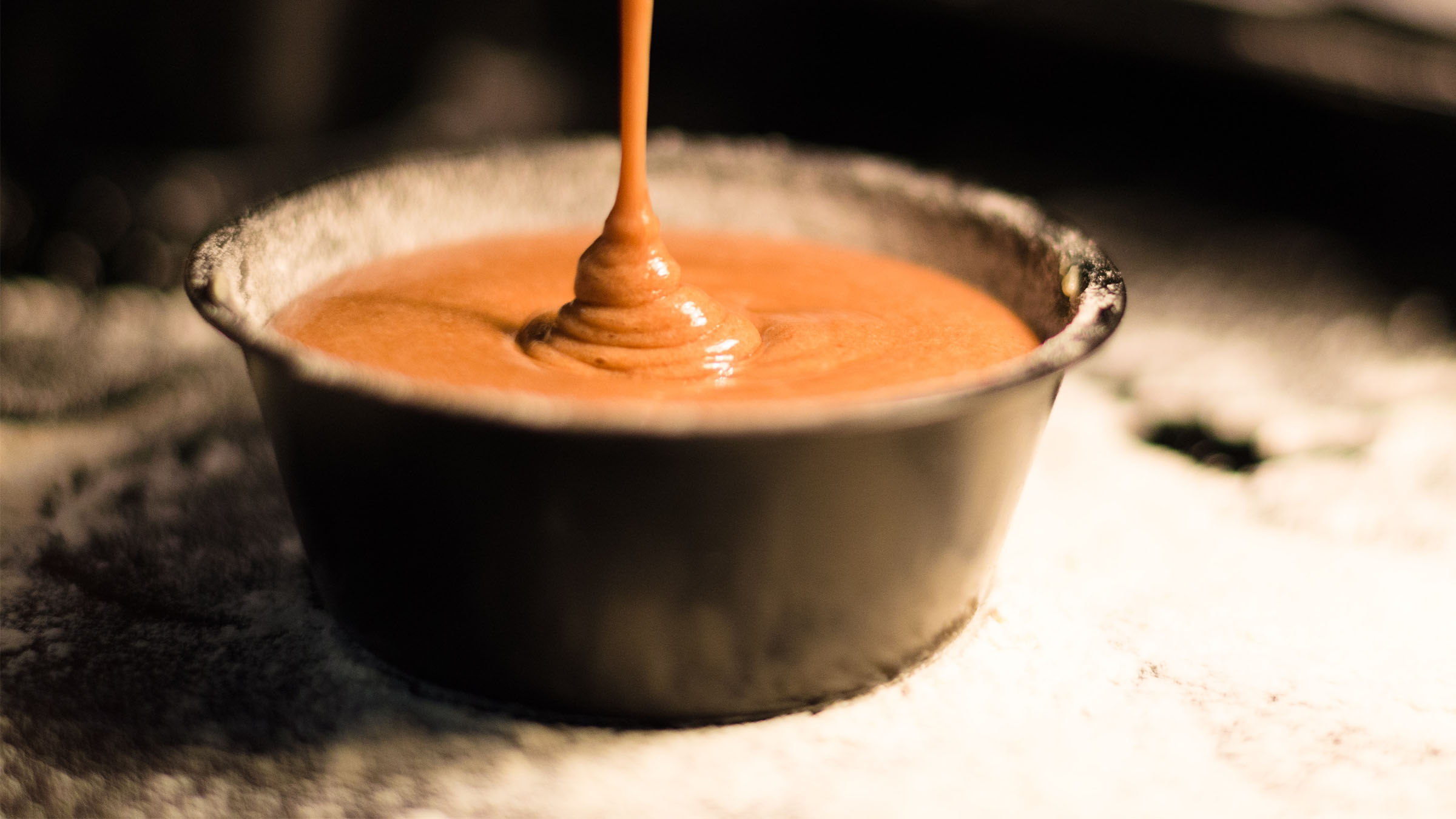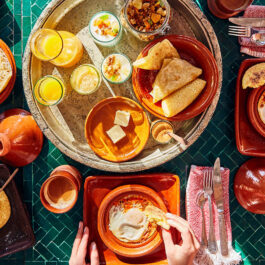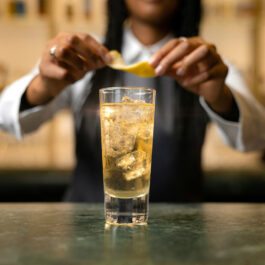Sometimes the simplest things are the most sublime: dulce de leche is undoubtedly one of them. Milk, sugar, a pinch of bicarbonate at most, and a hint of vanilla: that’s all it takes to make this creamy delicacy, with its velvety texture and intense flavour that captivates anyone who tastes it.
It is a dessert with many names. What Argentinians and Uruguayans call ‘dulce de leche’, Mexicans refer to as ‘cajeta’. In most of Colombia and Venezuela it’s called ‘arequipe’, while in Nicaragua it is ‘bollo de leche’. Cubans have ‘fanguito’, Bolivians ‘manjar blanco’, Panamians ‘bienmesabe’, and Chileans and Ecuadoreans ‘manjar’. It is known as ‘doce de leite’ in Brazil and Portugal, whereas the French call it ‘confiture de lait’ – literally ‘milk jam’.
The French are onto something: dulce de leche is smooth and simple as a jam, the result of reducing milk and sugar to thicken and slowly caramelise it. The chemical processes that take place as the milk proteins and sugars reduce – called the Maillard reaction – lend it a colour and sweetness that is as unique as it is unforgettable.
Given the short list of ingredients, and the simple recipe for its production, it’s not surprising that dulce de leche has played a role in different gastronomic cultures for hundreds of years. Each one of them, with its nuances and slight differences, claims to have created it – and probably more than one of them is right.
The Variations
Not all dulce de leche is the same: in fact, manjar blanco is made in some countries with both evaporated milk and condensed milk, and there are even recipes using rice in the preparation. Originally it was lighter-coloured, whitish with almost a fluid cream consistency, and in some Central American countries it still is. Then there’s the version found in India’s ancient gastronomic and spiritual culture Ayurveda, made with condensed milk and corresponding to the dessert more commonly called “rabri”.
Although cow’s milk is usually used, and the original recipe (as far as we know) was conceived with this ingredient, you can also find iterations with goat’s and sheep’s milk. The intensity of flavour in the former and the extra fat in the latter will be the most important differences in the result. It is also possible to replace all or part of the sugar cane with coconut sugar or glucose.
Finally, there are vegan versions, where the animal milk is replaced by coconut, soya or almond-based ‘milk’ drinks – but if you’re searching supermarket shelves for vegan dulce de leche, note that the food regulations in certain countries do not allow it to be labelled ‘dulce de leche’ for marketing purposes.

[Photo courtesy of Natalia Kiako from her book Cómo Como]
The Origin
As with many other classic dishes and traditional recipes around the world, there are countless versions and myths surrounding dulce de leche. In Argentina, the most widespread story tells that it came about by chance in 1829, when a cook working for Juan Manuel de Rosas – an important Argentine military and political figure – forgot the ‘lechada’ (sweetened cow’s milk) she was making, and burned it over the fire. The reason for her forgetfulness, they say, was the impending arrival of General Lavalle, another famous character of local history. Similar stories circulate in Chile (with O’Higgins and San Martín as protagonists), though none such tales seem to have much basis in fact.
There are records in the Argentine province of Mendoza long before this, between 1693 and 1712, of the importation of several jars of “manjar”, and in Chile there are accounts of its consumption since colonial times. Similarly, written records of dulce de leche production exist in Brazil’s Minas Gerais region around 1773, and in Uruguay it’s said that dulce de leche was common among slaves in colonial times, taking advantage of the high caloric value of the preparation.
Going even further, historian Daniel Balmaceda indicates that the recipe already existed in Indonesia around the 17th century, and that it travelled from there to South America via the Philippines, in the hands of the Spanish crown. There is even a European legend, similar to the one about Roses, according to which Napoleon’s cook was responsible for the culinary invention that still captivates us today.

[Photo courtesy of Natalia Kiako from her book Cómo Como]
The Indulgence
Say ‘dulce de leche’ within earshot of a child, and most will grab a spoon and head straight for the jar. Eating it ‘pure’ is common, such as in Argentina where it’s commonly eaten at breakfast, spread on toast with butter or cream cheese. It’s also a key ingredient in many desserts across Latin America, stuffed into pastries or shaped into soft candies, where cooking is usually extended for a longer time to evaporate excess liquid, or thickeners are added to obtain a solid jam.
Depending on the purpose, dulce de leche can be prepared with different textural characteristics and flavour intensity. When it is made with a fuller, thicker body, so that it retains its shape without spilling over, it is called ‘dulce de leche pastelero’. When it is thick and firm to the point of being able to be sliced, we are talking about ‘dulce de leche alfajorero’. ‘Heladero’, on the other hand, has a more intense colour and flavour, allowing it to be added to ice cream.
In its most basic, traditional form, however, dulce de leche is very easy to make using just a few ingredients and a couple of simple tips, which we share in the recipe below.
The Recipe: Basic Dulce de Leche
Ingredients:
1 litre of milk, preferably whole milk
300 grams of white sugar
½ tsp bicarbonate of soda
1 vanilla pod or 1 tbsp vanilla extract
Method:
Tip: Ideally, dulce de leche should be prepared in a thick, heavy pot or pan, whether it is made of copper, iron or steel. This will facilitate the process of thickening the confection without sticking or burning.
1. Heat the milk in the pan over a low heat, but do not bring it to boil. Once heated, add the vanilla and sugar, stirring with a wooden spoon to help dissolve the sugar in the milk.
2. Now bring to a boil and add the bicarbonate, which will prevent the milk from coagulating. (At this point, some people dip a small saucer into the pan or add some glass marbles, which will vibrate and bob and reduce the amount of stirring necessary). Reduce heat and cook over medium heat, without boiling, for between 1 and 1.5 hours, checking periodically that the milk does not burn and stirring with a spoon – forming figure eights inside the pot – to check the point reached.
3. After about 1-1.5 hours, the confection should have taken on the typical colour of dulce de leche. Keep stirring more often, continuing the process until the desired consistency has been achieved. To test it, remove a spoonful and leave it to cool on a small plate: this way you will be able to see the real texture.
4. To preserve it, pour it into sterilised glass jars and seal. If sealed and refrigerated, it can keep for up to 1 year. If the container is pasteurised, it can be stored in the cupboard at room temperature for the same period of time.














Sorry, the comment form is closed at this time.